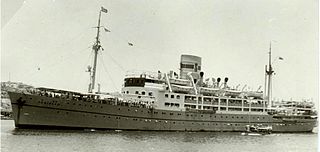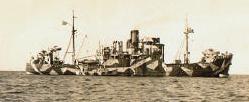Stettin was a 2,646 GRT cargo ship which was built in 1923 for the Stettiner Dampfer Compagnie. In 1930 she was sold to Norddeutscher Lloyd and renamed Akka. She was requisitioned by the Kriegsmarine in 1940. Akka was seized as a war prize in 1945, passing to the Ministry of War Transport (MoWT) and being renamed Empire Calder.
Mironave was a 1,125 GRT cargo ship that was built as a passenger ship in 1938 by Schiffbau-Gesellschaft Unterweser AG, Wesermünde, Germany for German owners. In 1940, she was requisitioned by the Kriegsmarine. Seized by the Allies in 1945, she was passed to the Ministry of War Transport (MoWT) and renamed Empire Concave. In 1946, she was passed to the Norwegian Government and renamed Galtnes. She was sold into merchant service in 1947 and renamed Ila. In 1952, she was sold to Brazil and was renamed São Leopoldo. In 1965, a further sale saw her renamed Mironave. She was still in active service in 1982, when a further sale took place.
V 1502 Wiking 6 was a German Vorpostenboot built in 1939 as the whaler Wiking 6. Requisition by the Kriegsmarine, she served throughout World War II as V 1502 Wiking 6 and the FlakjägerFlJ 24 Wiking 6 before being seized by the Royal Navy at Emden on 29 October 1945 and renamed Empire Viking VI. Allocated to the Soviet Union in 1946, she was renamed Slava II.
Seydlitz was a German trawler built in 1936 which was converted into a Vorpostenboot for the Kriegsmarine during World War II, serving as V 201 Seydlitz and V 211 Seydlitz. She was bombed and sunk off the Channel Islands on 20 March 1944.
V 105 Cremon was a German trawler built in 1922 which was converted into a Vorpostenboot for the Kriegsmarine during World War II.

Jagiełło was a medium-sized passenger-cargo ship, sailing under the Polish flag between 1948 and 1949, and then decommissioned due to unprofitable and post-war political conditions, which were not conducive to the development of the Polish passenger fleet, and then transferred to the Soviet Union as Pyotr Velikiy, operating Black Sea passenger services until 1973. The ship had been built by Blohm & Voss for Turkish operators, taken over after completion by the German government. After World War 2 it taken over by the British and then the Soviet Government.
V 108 Porjus was a German cargo ship that was converted into a Vorpostenboot for the Kriegsmarine during World War II. After the war, she returned to civilian service as a cargo ship in Greece, being known by the names Alkimini, Vassilakis and finally Mona. The ship was wrecked off Cheka on 27 November 1976.
V 107 Botilla Russ was a German cargo ship which was converted into a Vorpostenboot and then a Sperrbrecher for the Kriegsmarine during World War II.
V 202 Franz Westermann was a German trawler built in 1937 which was converted into a Vorpostenboot for the Kriegsmarine during World War II. She was sunk at Saint Peter Port, Guernsey, Channel Islands in an allied air raid on15 June 1944. Repaired post-war, she was renamed Pommern in 1954 and served until 1960.
Carl Röver was a German fishing trawler which was requistioned by the Kriegsmarine in the Second World War for use as a vorpostenboot, serving as V 209 Carl Röver and V 203 Carl Röver. Severely damaged in the war, she was repaired post-war and re-engined. She served as the fishing trawler Essen and was later converted to a cargo ship. She served as Hans Peter, Handsome, Handsome I, Walid and Samir under the flags of West Germany, the United Kingdom, Panama and the Lebanon. She was lost in 1985.
V 104 Falke was a German-built cargo ship which was converted into an auxiliary warship for the Kriegsmarine as a Vorpostenboot and then Sperrbrecher. The ship was built as Toreador and was also known as Poldorf and Düsseldorf.

Rhineland was a 1,312 GRT cargo steamship that Howaldtswerke of Kiel, Germany built in 1938 for Argo Line, Bremen. She was requisitioned by the Kriegsmarine in 1939, and served as VP-101 Schwan, Sperrbrecher 31 and Sperrbrecher 131. She served post-war with the German Mine Sweeping Administration before being declared a prize and passed to British owners. She was renamed Weltonwold in 1948 and then Rhineland in 1949. She was sold to South African owners in 1956 and renamed Herrisbrook. She was renamed Inyoni in 1957 and scrapped in 1962.
Phönix was a cargo ship built in 1913 by Stettiner Oderwerke, Stettin, Germany for Dampfschifffahrtsgesellschaft Argo AG, Bremen, Germany. She served with a number of German shipping lines before being requistioned in 1939 by the Kriegsmarine as VP-106 Phönix, later serving as Sperrbrecher 36 and Sperrbrecher 136. She was scuttled at Saint-Nazaire, Loire-Inférieure, France on 25 August 1944.
Friedrich Karl was a cargo ship which was built by Neptun Werft, Rostock in 1938. She was requisitioned by the Kriegsmarine during the Second World War, serving as the vorpostenbootV 108 Friedrich Karl and the sperrbrecher Sperrbrecher 138. She struck a mine and sank off Borkum on 23 December 1942.
Reiher was a 975 GRT cargo ship that was built in 1909 by Bremer Vulkan, Bremen, Germany for Argo Line. She was renamed Flamingo in 1938 and was requistioned by the Kriegsmarine in 1939, serving as the vorpostenbootV-109 Flamingo and the sperrbrecherSperrbrecher 39 and Sperrbrecher 139. She struck a mine and sank off the coast on Norway in February 1945.
V 404 Baden was a German fishing trawler that was requisitoned by the Kriegsmarine during the Second World War for use as a vorpostenboot. She was built in 1930 as Jakob Goldschmidt and was renamed Baden in 1933. She served as V 214 Baden and V 404 Baden. Scuttled in 1944, she was raised post war and became the French cargo ship Docteur Edmond Papin. Sold to the United Kingdom in 1961, she was scrapped the next year.
V 303 Tannenberg was a German fishing trawler that was requistioned in the Second World War by the Kriegsmarine for use as a vorpostenboot. She was returned to her owners post war. In 1958, she was re-engined and converted to a cargo ship. In 1970 she was sold to Greece and renamed Panaghia. She was sold to Panama in 1975 and was renamed Nikos then Chantal. She was wrecked in 1978.
V 304 Breslau was a German fishing trawler that was requisitioned in the Second World War by the Kriegsmarine for use as a vorpostenboot. Built in 1925 as Weser, she was renamed Breslau in 1939. She was wrecked at the entrance to the Noordzeekanaal in 1940.
V 305 Ostpreussen was a German fishing trawler that was requistioned in the Second World War by the Kriegsmarine for use as a vorpostenboot and later a Vorpostensicherungsboot. She was returned to her owners post war. In 1957, she was re-engined, converted to a cargo ship and renamed Stella Maris. Sold to the Netherlands that year, she was scrapped in 1958.
Osdorf was a German fishing trawler that was built in 1921 as Rendsburg. Renamed in 1939, she was requisitioned by the Kriegsmarine in the Second World War for use as a Vorpostenboot, serving as V 311 Osdorf. Restored to her ownes post-war, she was sold to Norway in 1951 and converted to a cargo ship, renamed Vestland. She was renamed Sirabuen in 1952, serving until 1956 when she was lost in a collision.

